Castlevania (NES Review)
October 26, 2023 13 Comments
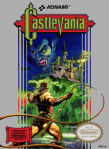 Castlevania
Castlevania
aka Akumajō Dracula
Platform: Nintendo Entertainment System
Developed by Konami
First Released September 26, 1986
Included in Castlevania Anniversary Collection

“EXCUSE ME! If you have a moment, I’d like to talk to you about our lord and savior, Jesus Christ! Hello? Anyone there? I’ll just leave this pamphlet here and come back tomorrow!”
My history with the original NES Castlevania is a personal one. I first experienced it in the mid-2000s, in the form of the Game Boy Advance NES classics re-release that I fished out of a sales bin. By that point, I’d played Symphony of the Night, Circle of the Moon, Harmony of Dissonance, and Aria of Sorrow. All games I absolutely loved, that I would have easily called some of my favorite games. Then, a few months after Aria released, I was critically injured in a life-altering car accident. The epilepsy I would develop at 16 stems from the head trauma sustained on that day. I’m lucky to be alive, frankly, but the injuries were pretty bad. It would be months before I could even hold silverware. The accident happened in November, 2003, but I didn’t really start gaming again until early 2005, after making my first genuine attempt late in the Summer of 2004 and finding that, while my right hand was healing nicely, my left hand just didn’t want to cooperate. The biggest problem was just holding the controller. My left hand was so badly damaged that its pinky has a permanent crook in it that still causes me controller-holding issues to this day, along with constant numbness in my fingertips. Early-on, action games were out of the question. When I finally started going again, my hands would cramp and/or fatigue really easily. Physical therapy helped, but I kind of figured video games were the physical therapy.
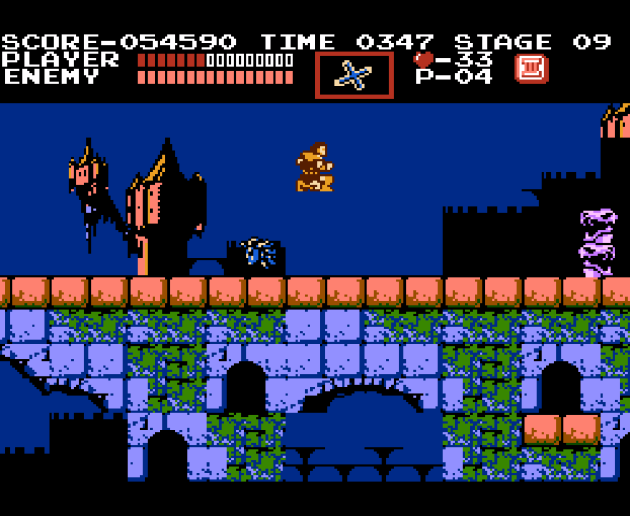
The most underrated aspect of Castlevania, IMO, is that it’s a milestone in settings and set-pieces. Like right here, where the location of the final battle with Dracula can be seen off in the distance. Even better is this comes at roughly the halfway point of the game. Video games didn’t typically do one-time backgrounds just for the sake of world building in 1986. Ultimately, a game designer is trying to create the illusion of an entire world out of a series of 1s and 0s. Castlevania’s world is more real than just about any franchise that got its start on the NES, including Super Mario, Zelda, and Metroid. It’s head-and-shoulders above them, in fact.
And then I got that original generation Castlevania, and Cathy got her groove back. By time I slew Dracula, a couple days had passed, and it felt like I’d gotten gaming back pretty much as I had it before. It was the perfect game for that, because it has some of the most pure, refined action on the NES. Nothing too advanced. No insurmountable odds. With two or three very rough exceptions, the OG Castlevania is action-platforming boiled down to its most base components. Castlevania isn’t as bold as you would think, mostly utilizing basic level design mentality. It’s mostly made up of straight corridors where enemy placement is 98% of the challenge. It’s why brief sections where the environment poses a threat stand out. Like the section pictured here:
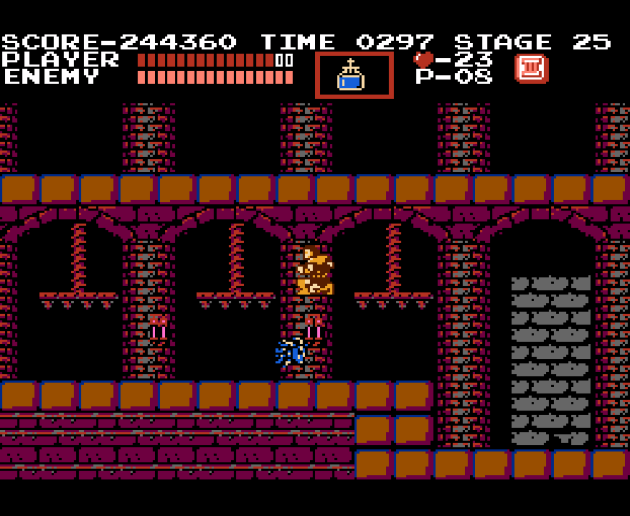
The flying Medusa heads only happen when you beat the game. And this is rough spot #1, because the collision on these is piss poor. Given how polished the rest of the game is, it’s kind of stunning how badly done it is. EVEN WORSE is that they didn’t improve it all that much in Castlevania 3 years later. Anyway..
Those three spiked presses are an iconic section of the game (granted, for all the wrong reasons) and they last, oh, maybe five seconds? And then they never show up again! Those are the only three instakill presses in the entire game. It’s kind of astonishing how restrained Castlevania is, but thank god for it, given how bad the collision for this section is. Later, a section underground where you have to hop across moving platforms to avoid falling down an instakill moat? Again, it lasts a few seconds, and then nothing like that shows up again, but that section is also pretty rough. It’s almost as if they realized the polish wasn’t coming along, so they stuck to the basics that they knew they were getting correct. You can see this when you compare those brief moments to the extended sections where the level design is just a straight line with maybe a couple blocks of debris or a split-level with staircases, and the gameplay is genuinely perfect. Honestly, it also kind of helps to make Castlevania feel like an actual castle, doesn’t it? Like, how many spiked presses does one Count need to own? Three feels more practical and ergonomic.

Castlevania is loaded with these hidden point secrets. Even though points are worthless without online leaderboards, I have to admit that every new time I’ve found one, I’ve squealed with delight. Is there a platform somewhere for no reason? There’s a good chance it’s to reveal one of these hidden treasures. Though not all of them are available in the first quest. The Gradius-based Moai statue can only be found after beating the game.
Castlevania’s levels are divided into “stages” marked by doors. The stages really mark the respawn points if you die, so I’m going off the overall levels. If there was an “Opening Level Hall of Fame” Castlevania would make it on the first ballot. An absolute masterclass in easing players into the game’s universe that never overwhelms but also never condescends. Whip the candles. Whip enemies. Climb stairs. Throw your sub-weapons. Basic stuff the instruction book covers, and with enemies that have generally basic attack patterns. The most common enemy, the ghouls, charge straight ahead. The bats fly at you in a slight wave pattern, and the panthers lounge before dashing at you. The most challenging of the first level’s basic enemies are the fishmen, who launch out of the water, but even then, they’re slow to react and allow players time to defeat them before they spit projectiles at you.

You’ll also notice their placement is spot-on. There’s no cheap shots in the first level. Having this small section in the water prepares you for a later, more dangerous encounter over a large section of water.
The choice and location of the enemies in Level 1 makes for a good confidence builder, but it also helps you to figure out the key to survival in Castlevania. There’s hidden stuff in the walls. How will players figure this out? In the very first instance of the health-restoring food hidden in the walls, the game has you encounter a bat that you can’t avoid. When you inevitably whip at it, you’re going to bust through the wall and reveal the food. By the way, this was one of the very few Angry Video Game Nerd lines that actually made me laugh. I chortled when he said the food must be “dirty.” Yea, food found randomly in a crumbling wall in a centuries-old castle owned by the embodiment of all that is evil having dirt on it would be my chief concern too.
It’s notable that the first level only has TWO jumps over pits, in the cellar with the fishmen. While later Castlevanias would balance jumping with combat, the original game very much is focused on fighting baddies. I counted out the jumps in the first five levels. There’s approximately two dozen where there’s a risk of dying directly due to the jumps, some of which are optional. And really, that’s through four levels, because the fifth level has NONE. Not a single jump over a pit. Wow! So, really, the first stage gets you where you really need: ready to whip a whole lot of enemies. Yet, as basic as it is, the setting is especially spooky. Tattered curtains and holes in walls. It’s creepy. Then, you see a giant bat hanging from the ceiling. Is it the Count already? Nope, but it is a pretty good first boss and the perfect cap to the perfect level. Yep, perfect. This is right up there with 1-1 in Super Mario Bros., the fight against Glass Joe in Punch-Out!!, and yes, even Green Hill Act 1 in Sonic The Hedgehog. First levels don’t get better, folks.
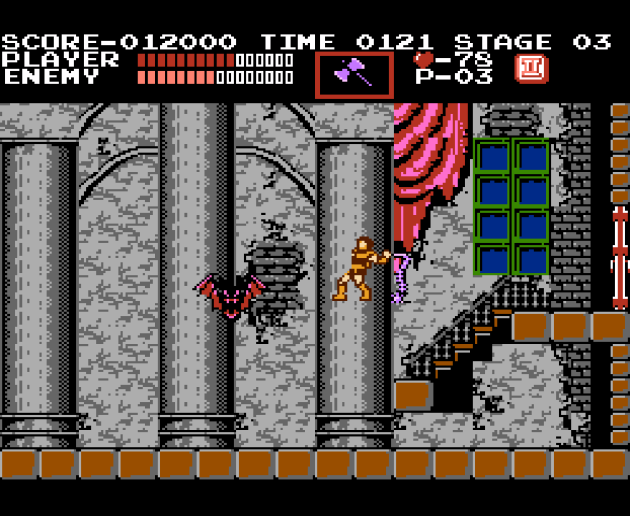
If you have the axe, this fight is a cinch. Especially with the first double shot in the game hidden right there. But, if you use the whip, it’s a much more intense and satisfying battle. You know, I don’t think I ever tried fighting Castlevania’s bosses without sub-weapons. You can tell they weren’t really made to be fought with the whip. Depending on where it lingers, you might have to wait for it to dive down and attack you to get your licks in.
Besides the spike presses, I don’t think there’s a single moment that Castlevania doesn’t prepare you for. Well, except maybe the Medusa heads. They fly in a giant sine wave pattern and are among the most annoying enemies in gaming history. If you think they’re bad now, try playing the second quest after you beat the game. “How do we make this harder? F*ck it! Just add Medusa heads!” This is also the introduction to one of Castlevania’s most quirky features: the ability to use being damaged to circumvent large sections of the stage. You see, Castlevania’s most notorious feature is the violent knock-back that happens when you take any damage. Well, at least when you’re not walking on the stairs. It can turn a flesh wound into an instakill down a pit. BUT, if you time it right, you can use it to do the world’s most masochist double jump, and in certain areas of the stage, it allows you to circumvent areas of the game. It’s rarely useful, at least in Castlevania I, but there’s a spot or two it works on. I imagine speed runners must love the Castlevania games. Hell, I’m not a speed runner and I was giddy when I pulled this move off for the first time, especially since there’s a health refill in the very next room.
The second level is also the introduction to the “any monsters will do” mismatch of cultures that makes Castlevania, well, Castlevania! The second boss is Medusa, who has absolutely nothing to do with vampire mythos, Transylvania, or gothic horror. It’s a Greek myth about a woman who had sex with a God, pissing off another God who decided to punish her for the nerve of having a little cuddle. Eventually mummies, the Grim Reaper, and even f’n Frankenstein show up. Why would Frankenstein be in a game set in 1691? Frankenstein takes place in the 1700s! And why the hell would he fight for Dracula? He wouldn’t be swearing his hatred for humanity for a few decades at the very least. Castlevania is like Monster Squad, only theoretically loonier, yet done without the satire or 80s stereotypes. It’s played with absolute sincerity, and it’s kind of scary.

I kind of like that she’s just a disembodied head. So this is post-Perseus Medusa. On the downside, she doesn’t even turn you to stone.. at least in this version.
In terms of gameplay, my biggest question is simple: are the sub-weapons overpowered? Actually, I think they are. With the right load-out, many enemies are reduced to little more than cannon fodder. The solution is simple: either the sub-weapons should cost more hearts or the game should give you less hearts. Only the stopwatch costs more than one heart to use, at a whopping five for five seconds worth of freezing enemies. Meanwhile, the easy-to-use boomerang, holy water, and axe cost you 1 heart each and they shred enemies and bosses, especially if you have the double/triple shot. The opening giant f’n bat? Four seconds with the axe. Medusa? I once took her down in three seconds with a triple boomerang (though I wonder now if I had it set to easy mode, because jeez, that looked pretty quick). And look at how you can fight the mummies with the holy water!
But, even if you don’t have a safe spot, you don’t need it. The holy water burns and stun-locks every boss, except Dracula’s first form, which is only vulnerable on its head. If you can pick-up holy water, you don’t need to spam it, like you do with the axe or boomerang. You need only to learn how to time it right. Now, granted, you have to actually not die, and you have to avoid grabbing any other weapon by accident. Assuming you do die, you’re still not totally screwed. If you’re not in the final stretch before the boss and you have the time to build up hearts, you can quickly get the double shot/triple shot back. There’s a trick to it that doesn’t require you to find these items in the walls. Every ten kills (including projectiles) with a sub weapon nets you the double shot/triple shot. If your aim is true, that means you only need ten hearts to net you the double shot and twenty to earn you the triple. With the exception of the final level, you should be able to do it quickly. Here I am with the triple shot knife right in the first section of the first stage, though I should note the double/triple shot dropped from candles, not baddies.
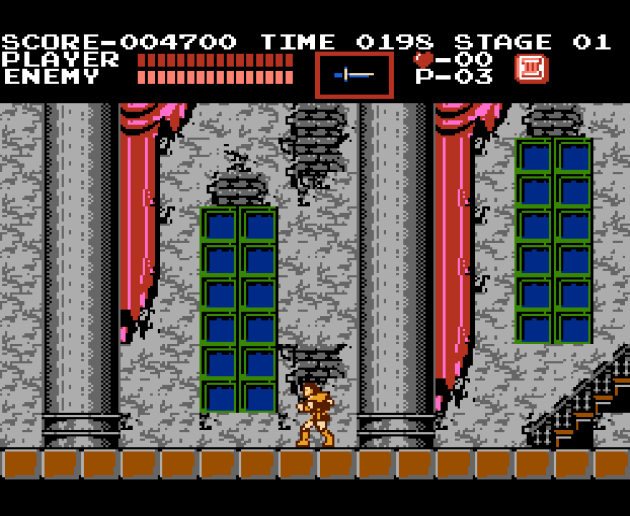
Granted, I had to grind-up hearts, but I’ll be damned.. it works!
Despite its reputation, Castlevania isn’t that difficult, at least through the first five stages. I never feel like the odds are overwhelming against you, and the enemies, even the Medusa heads and hunchbacks, have easy-to-grasp patterns and predictable placement. Castlevania 1 is a very clockable game. Maybe it’s hard the first time, but it’s easy to learn and satisfying to master. NOT difficult to master, but satisfying. For this review, I ran through the game three times. In my run on the Japanese version, I played terribly in the fourth stage, with only two ticks of health left going into Frankenstein’s Monster. Having two ticks of health left is basically saying “one more hit and you’re dead.” But Frankie and the hunchback that sat on his shoulder didn’t even get a chance to move thanks to my triple-shot holy water. That was around the time I realized “um.. I haven’t died yet.” And that brings me back to the whole “personal journey” Castlevania has been a part of.
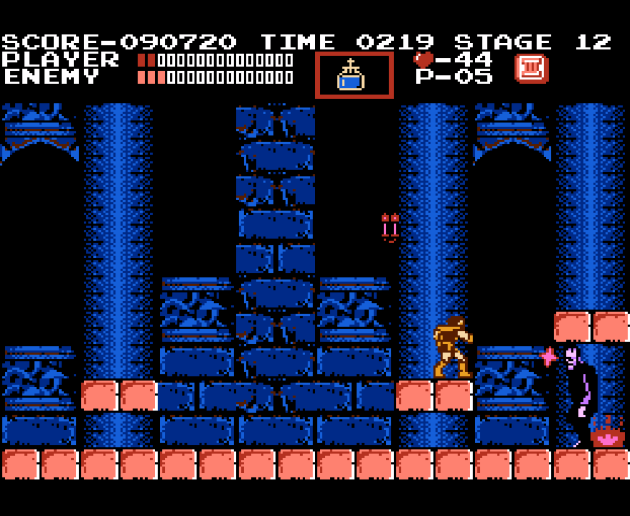
“Oh well, it beats being played by Robert De Niro.”
In 2005, a full six years before I started Indie Gamer Chick, I didn’t know Castlevania was the perfect action game to help me build my timing and my confidence back. I thought I was just going to play it for an hour or two and put it back in my case. I’m lucky, really. Retro gaming wouldn’t be on my radar for well over a decade after I picked it up. If it hadn’t been on clearance, I don’t think I’d have bought it. My curiosity as to what it would be like could best be described as mild. I never imagined it would be such a milestone game for me that I end up going back to it from time to time. Replaying Castlevania as an adult really started four years ago, with Castlevania Anniversary Collection. I still enjoyed it just fine, but by that point, I’d played the superior Castlevania III, which I not only liked more, but I considered to be the best NES game ever made. And Super Castlevania IV, nerfed as it is, is a damn good time. Both those were, you know, IN THAT COLLECTION! Castlevania 1? A slightly-overrated game with only six levels that’s mostly straight corridors? Why, that one is downright fuddy duddy.
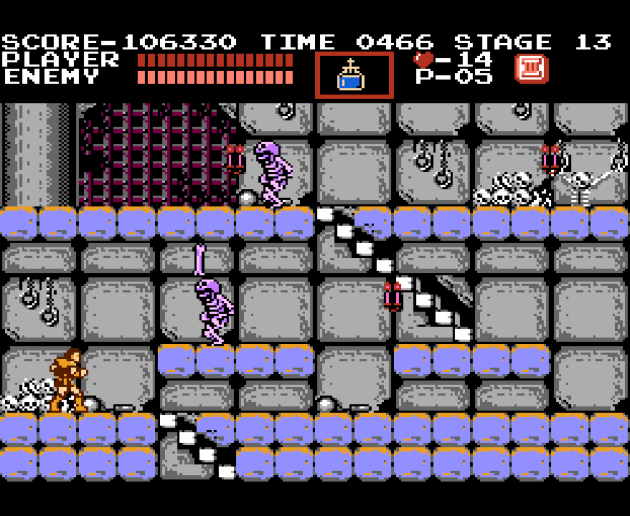
I used to quake in my booties over the stairs. Not so much anymore, though I imagine that’ll change for Castlevania III.
It wasn’t until I replayed the game when they added Japanese ROMs to Anniversary Collection that I came to admire the fact that Castlevania 1 laid out the perfect foundation for a game franchise in a measly six levels of action. By this point, I found myself replaying it pretty frequently, usually as an excuse to review other things Castlevania-related. I reviewed a series of ROM hacks based on it (read that HERE). Or, hey, I got a TurboGrafx 16 mini and it has Rondo of Blood? Well hell, I might as well bust-out Castlevania 1 again! Along the way, I noticed something: I was getting pretty dang good at it. Slowly but surely, I phased out using save states and rewinding, and the next thing I know, I’m beating the game without cheating every single time. I’d only done that once before, back when I was 15 years old and recovering from that f’n accident, but this was different. Because not only had I beat it without cheating, but the first time I did it in my modern IGC existence, I only died once!

Why would the Grim Reaper work for Dracula? Shouldn’t it be the other way around? Yea, I’m sure this is “explained” and then retconned and explained in another way but, yea, no. It’s the goddamned Grim Reaper! Dracula should be working for it. OR, maybe he does. Maybe Drac got Simon Belmont’s post-it note. Now there’s an obscure reference.
The idea that I could beat Castlevania without losing even one life seemed far-fetched back when I first played the game in 2005. It’s got a reputation, and even at my best, I was never that good. After I had another single-death run last year, it didn’t seem so far-fetched anymore. Part of it is memorization. I know which candles NOT to whip mid-air that would take away my weapon. I know that the triple holy water and not the triple boomerang is the key to making the game absurdly cheesable. I know where the enemies are going to be coming from and can avoid being knocked backwards into a pit. My second one-death run’s one fatality was in the dumbest possible spot. This one:

See that little hole between me and the stairs and the skeleton? Yea, well, I didn’t.
On the plus side, I would never forget that hole was there ever again. Really, as long as you practice with the holy water, don’t take any candles that are a risk of death by falling, memorize where the enemies are going to be during the pits (which there aren’t as many pits as you’d think) you can do it too! Getting deep without dying in Castlevania isn’t that hard. Sacrilege, I know, but I’m NOT a professional gamer. Not even close. But, I realized a couple years ago that acing Castlevania didn’t feel as unfathomably out of reach like it would for my other favorite NES games such as Life Force or Contra. I knew I could do it. Long before I was making single-death runs in Castlevania, I was so proud of myself for not taking any damage in the “Infamous Hallway” that leads to the Grim Reaper on my first time playing it on Anniversary Collection. Now, I can do that every single time. It’s not that tough, actually. My mistake was relying on the boomerangs. My logic seemed sound: they travel nearly the full length of the screen AND then come back, dealing double the damage. But, the knights can shield the boomerangs, and bosses aren’t permanently stun-locked by them. They have no defense against the holy water. These days, I have that hallway down to a science. It’s easy once you figure out how to rush and manipulate the enemies.
It’s not until the final level that Castlevania truly becomes a monster. Few NES games build up to a perfect crescendo quite like it. The funny thing is, it’s BY FAR the shortest level. It’s not even close, actually. But, the challenge is incredible. The giant f’n bat that’s the first boss? The final level starts with a broken bridge that has five of them! And it’s not like they nerfed them for this section. They take as many hits as before, and you don’t have the hearts to just spam them with sub-weapons. That’s why I did the most heroic thing I could do: I legged it.
Then, after a brief encounter with some bone-throwing skeletons, you move onto a section that features the hawks dropping hunchbacks on you. The game fed you these before as you navigated a literal straight line with no jumps. This time around, it’s easily the most difficult section of the entire game. That includes all the bosses. This brief section contains huge staircases, tight jumps, close quarters, all made significantly harder by the fact that the walls are designed to allow the hunchbacks to jump up from below you, with no means to stop them. This is the final stretch before Dracula, and it’s brutal.

I had a rough guesstimate on how many hearts I’d need to beat Dracula, and I knew how many hearts were available in his arena. Once I knew I had enough, I botled the exit.
It was when I managed to make it through that section with full life that I realized “holy crap! I’M GOING TO DO IT! I’M GOING TO ACE THE GAME!” Then I almost blew it against Dracula, who has two forms, the first of which is only vulnerable in the head and can’t be stun-locked by the holy water. After starting out hot, I blew three consecutive attacks from him. I was down to one final hit when I took his head off. At which point, like so many other bosses, his final form I could stun lock by timing my tossing of the holy water. Not too fast. Not too slow. A nice steady pace and he was toast, and I’d done it. And it feels so good.
I can’t imagine what Castlevania must have been like for first-time players in the mid-to-late 80s. It had to have been mind blowing how immersive it is. It looks better than any NES game released up to this point. It sounds better. It controls better. As far as games with fixed-jumping goes, it’s very intuitive. Dare I say, the best fixed-jumping on the NES. It’s a charmer, too. The fact that it’s got Dracula, Frankenstein, mummies, Medusa, skeletons, etc, yet it plays them completely sincerely, tongue never in cheek? I mean, come on. It’ll charm the socks right off you! That uniqueness is lost in 2023. Hell, some of their Frankenstein designs in the years since have been embarrassing, and the series took a hard turn into the cheesy territory when Dracula started to monologue on what exactly a man is. I think part of why the original Castlevania holds up pretty dang well is because it has such sincerity. There’s nothing pandering or cynical about it. Well, at least until those end credits. Golly, those were an ominous sign. But, otherwise, Castlevania holds up to the test of time.
But, what truly makes it timeless, at least for me, is the fact that it’s a “hard” game that’s easy to commit to memory, learn the patterns for, and ultimately overcome and triumph in ways I never thought possible. It’s not even the best Castlevania on the NES, but it is the closest to actual gaming perfection. I think if I put in the type of time and effort I have for games like Dead Cells or Cuphead, I really think I could eventually do a no-hit run on it. What once felt impossibly out of reach now feels like it’s doable. It’s not as if I had to practice at Castlevania for years to get good enough to run through it in a single life. I’ve played it sporadically-at-best since 2019, and ultimately, it was just knowing what item to use (triple holy water, not triple boomerang) and memorizing which candles NOT to whip that put me over the top. Taking no hits will require more time and patience, and there’s sections I’ve never played perfectly. I’m worried about the Grim Reaper. I’m worried about that final stretch before Dracula. I’m worried about Dracula himself. But, impossible? I don’t think so. Do you know what the best thing I can say about Castlevania is? It’s a game that was released a little less than three years before I was born, and I’m sitting here legitimately contemplating whether I could play it perfectly or not, and there’s only one thing I know for sure: I wouldn’t be bored trying.
Verdict: YES!

Amazing game and an amazing story to go with it!
Pingback: Castlevania III: Dracula’s Curse (NES Review) | Indie Gamer Chick
Which Castlevania – would you say – can someone start into this game series?
I got Lords of Shadow but it feels like there’s context missing, so I’m not sure to go with another one first or continue
There are TWO tiers of Castlevania: the ones that are linear platformer and the ones that are Metroidvanias – vast, sprawling adventures, especially making Castlevania a franchise with two types of games.
For the linear ones, 3 is the best IMO and Super Castlevania is a great spectacle.
For the Metroidvania ones, I’d get the Castlevania Advance Collection, which has four really great games, and do Circle of the Moon.
I see, I’ll look into it more to decide where to start from!
Actually, never mind what I just said: what you should do Sammy is get Anniversary Collection AND Advance Collection, and between those two sets, you’ll get the grand tour of Castlevania. The only truly great Metroidvania one you’d be missing is Symphony of the Night, which is a teeny tiny bit overrated, as I feel the GBA games did the same concept more refined and polished. And, Anniversary would give you 1, 3, Super Castlevania, and Bloodlines. PLUS you’d get Castlevania parody Kid Dracula which is actually a VERY good video game in its own right. You’d be good to go and get a feel for why the franchise is a rightful legend.
Gotcha, thank you! I’ll give them a look!
And they got on 50% off sale constantly so you could probably score both combined for under $30.
So, would you say Lords of Shadow is technically not needed at all for the story and all?
I think the story is just too bonkers to take seriously anyway, but if I’m not mistaken Lords of Shadow is a complete reboot that didn’t really “take” canonically.
Ohh I see! Gotcha!
Pingback: The Storied Sword (NES Indie Review) | Indie Gamer Chick
Pingback: Atari 50: The Games They Couldn’t Include – Part Three | Indie Gamer Chick